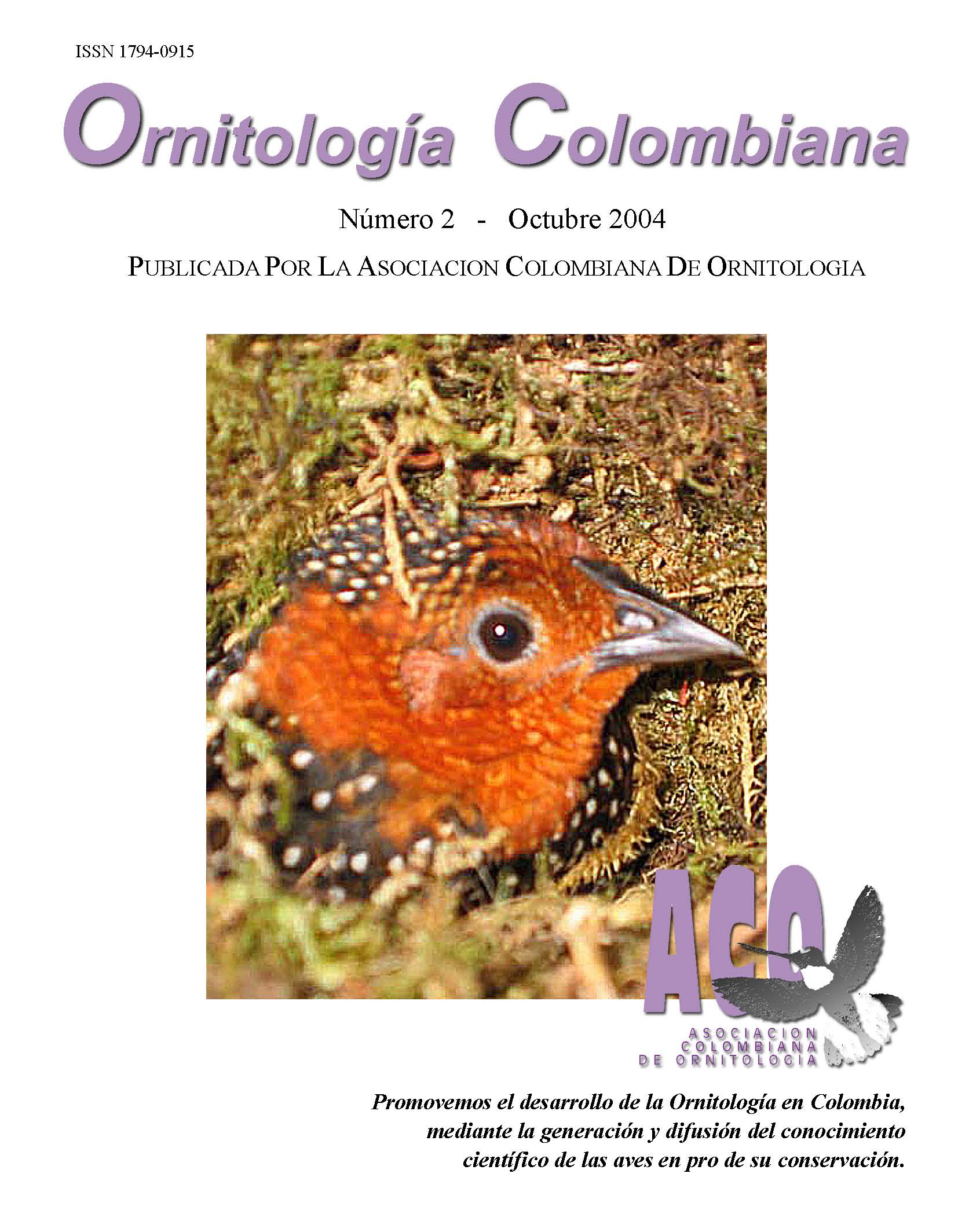Habitat and distribution model of the Horned Lark (Eremophila alpestris peregrina) in the Altiplano of Cundinamarca and Boyacá, Colombia
Habitat and distribution model of the Horned Lark (Eremophila alpestris peregrina) in the Altiplano of Cundinamarca and Boyacá, Colombia
DOI:
https://doi.org/10.59517/oc.e30Keywords:
Colombia, Horned Lark, Eremophila alpestris, habitat models, species distributions, Geographic Information Systems, Remote SensingAbstract
The Horned Lark Eremophila alpestris peregrina is an endemic and threatened subspecies of the Altiplanos of Cundinamarca and Boyacá in Colombia. Based on literature and field data, a habitat model with Remote Sensing and Geographic Information Systems was generated in order to predict areas with suitable habitat for the species. The model predicted the Horned Lark’s habitat with a precision estimated as 64%, and 34 additional localities were found. Habitat variables were measured and described and the main threatening factors for the species were identified. Various recommendations are given for the conservation of the species.
Downloads
References
Allaby, M. (ED). 1998. Dictionary of Ecology. Oxford University Press, Oxford.
Alzate, B.E. 2001. Talleres Sistemas de Información Geográfica II. Departamento de Geografía, Universidad Nacional de Colombia, Bogotá. http://www.humanas.unal.edu.co/geografia/index.htm (15-07-2002)
Armenteras, D. 2001. Modeling the Distribution of Potential Biodiversity in Colombia Using Geographical Information Systems. Upgrading Report. Department of Geography. King’s College, Londres.
Asociación Bogotana De Ornitología. 2000. Aves de la Sabana de Bogotá; guía de campo. ABO, CAR; Bogotá, Colombia.
Bailey, J. 1996. Pocket factfile of birds. Borders Press, Ann Arbor, MI, USA.
Beason, R. 1995. Horned Lark (Eremophila alpestris). En: Poole A. & F. Gill (eds.). The Birds of North America, N°195. The Academy of Natural Sciences, Philadelphia, y the American Ornithologists’ Union, Washington, D.C.
Beason, R.C. & E.C. Franks. 1974. Breeding behavior of the Horned Lark. The Auk 91: 65-74.
Bock, C.E. Y B. Webb. 1984. Birds as grazing indicator species in southeastern Arizona. Journal of Wildlife Management 48: 1045-1049.
Boone, R. & W. Krohn. 2000. Predicting broad-scale occurrences of vertebrates in patchy landscapes. Landscape Ecology 15: 63-74.
Brown, J. & M. Lomolino. 1998. Biogeography. Sinauer, Sunderland, MA, USA.
Cadena, C.D. 2002. Eremophila alpestris. En: Renjifo, L.M., A. M. Franco, G. H. Kattan, J.D. Amaya & M.F. Gómez, editores. Libro Rojo de aves de Colombia. Instituto Alexander von Humboldt, Bogotá, Colombia.
Castrale, J.S. 1982. Effects of two sagebrush control methods on nongame Birds. Journal of Wildlife Management 46:945-952.
Clark Labs 2000. IDRISI 32. Clark University, Worcester,MA, USA.
Cramp, S. (ed.) 1988. Handbook of the birds of Europe, the Middle East and North Africa: The Birds of the Western Palearctic, Volume V: Tyrant Flycatchers to Thrushes. Oxford University Press, Oxford.
Dale, V., A.W. King, L.K. Mann & T. Ashwood. 2000. Contribution of spatial information and models to management of rare and declining species. En: Hill, M. y R. Aspinall (eds.). Spatial information for land use management. Gordon and Breach Science Publishers, Amsterdam.
Dinkins, M.F., A.L. Zimmerman, J.A. Dechant, B.D. Parkin, D.H. Johnson, L.D. Igl, C.M. Goldade & B.R. Euliss. 2001. Effects of management practices on grassland Birds: Horned Lark. Northern Prairie Wildlife Research Center, Jamestown, ND, USA. Northern Prairie Wildlife Research Center Home Page. http://www.npwrc.usgs.gov/resource/literatr/grasbird/hola/hola.htm (16-06-2000).
Goun. 2001. Protejamos las aves amenazadas del Embalse de Tominé. Grupo de Ornitología Universidad Nacional de Colombia. www.geocities.com/alondra_goun.index.htm (18-08-2001)
Habitat Models. http://www.esd.ornl.gov/programs/SERDP/EcoModels/habmodel.html (25-07-2002)
Hilty, S.L. & Brown, W.L. 1986. A guide to the birds of Colombia. Princeton University Press, Princeton, NJ, USA.
Instituto Desert.Definiçao de aridez. http://www.desert.org.br/sobre_desert/conceitos/aridez.html (30-12-2001)
Jonnson, L. 1991. Birds of Europe, with North Africa and the Middle East. Princeton University Press, Princeton, NJ. USA.
Line, L. 1997. Twilight of America’s grasslands. National Wildlife Abril/Mayo 1997. http://www.nwf.org/natlwild/grassam7.html
Npwrc. Breeding birds of the Platte River valley. Horned Lark -- (Eremophila alpestris) Northern Prairie Wildlife Research Center, Jamestown, ND, Northern Prairie Wildlife Research Center Home Page. http://www.npwrc.usgs.gov/resource/distr/birds/platte/species/eremalpe.html (12-02-2002)
Orstom & P. Le Goulvien. 1984. Estudio regional integrado del Altiplano Cundiboyacense. Anexo de Balances Hídricos. IGAC-ORSTOM, Bogotá.
Owens, R.A. & M.T. Myres. 1972. Effects of agriculture upon populations of native passerine Birds of an Alberta fescue grassland. Canadian Journal of Zoology 51:687-713.
Renjifo, L.M., A.M. Franco Maya, J.D. Amaya Espinel, G.H. Kattan & B. López-Lanús (eds). 2002. Libro Rojo de Aves de Colombia. Instituto Alexander von Humboldt y Ministerio del Medio Ambiente. Bogotá, Colombia.
Sample, D. & M. Moss. 1997. Managing habitat for grassland birds. A guide for Wisconsin. Wisconsin Department of Natural Resources, Madison.
Sutherland, W. 2000. The Conservation Handbook. Research, Management and Policy. Blackwell Science, Oxford.
Uicn. 2001. Categorías y criterios de la Lista Roja de la UICN: Versión 3.1. Comisión de Supervivencia de Especies de la UICN. UICN, Gland, Suiza y Cambridge, Reino Unido.
University Of Maryland. 2001. Global Land Cover Facility. http://glcf.umiacs.umd.edu (12-09-2001)
Valencia, I.D. 2002. Modelo de hábitat y distribución geográfica de la alondra Eremophila alpestris peregrina en el Altiplano Cundiboyacense, Colombia. Tesis, Departamento de Geografía, Universidad Nacional, Bogotá.
Vickery, P., J.R. Herkert, F.L. Knopf, J. Ruth & C. Keller. Grassland birds: An overview of threats and recommended management strategies. http://birds.cornell.edu/pifcapemay/vickery.htm (18-07-2002)
Whitmore, R.C. 1980. Reclaimed surface mines as avian habitat islands in the eastern forest. American Birds. 34:13-14.
Wiens, J., J. Rotenberry & B. Van Horne. 1987. Habitat occupancy patterns of North American shrubsteppe birds: The effect of spatial scale. Oikos 48: 132-157.
Downloads
Published
Issue
Section
License

This work is licensed under a Creative Commons Attribution-NonCommercial 4.0 International License.





